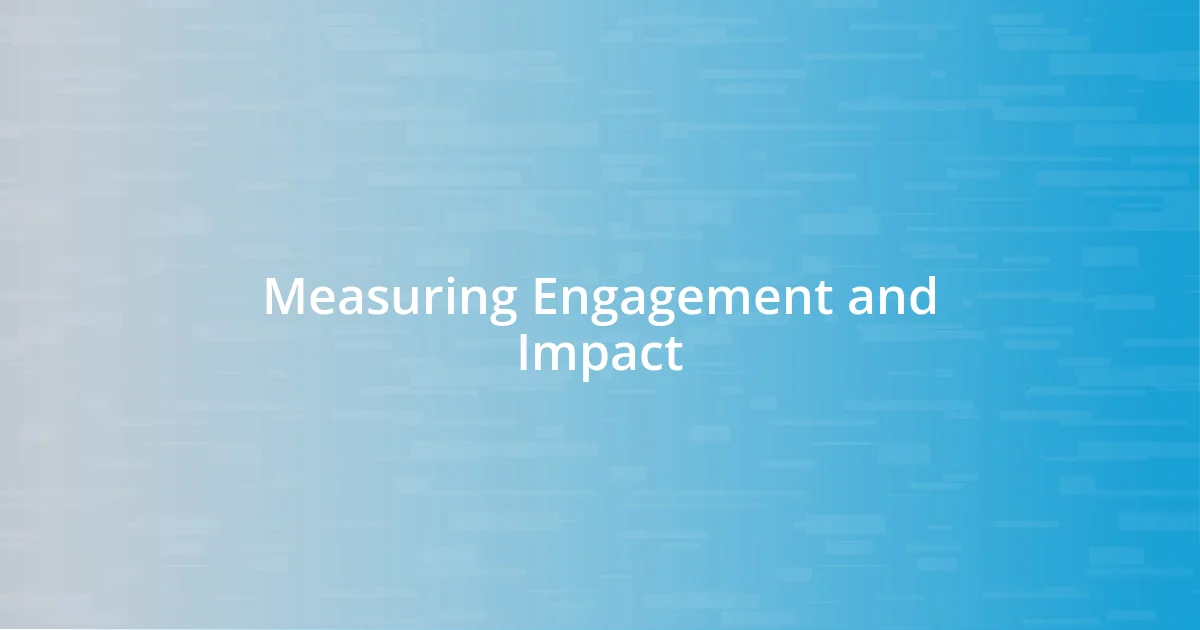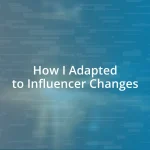Key takeaways:
- Understanding brand content goals requires crafting emotionally resonant narratives, enhancing awareness, loyalty, and driving conversions.
- Identifying the right influencers is essential; focus on value alignment, audience engagement, and analyzing past collaborations for authenticity and quality.
- Measuring engagement and impact involves both quantitative metrics and qualitative feedback, allowing for adaptive strategies that enhance content effectiveness.

Understanding Brand Content Goals
When I first dipped my toes into the world of brand content, I realized that understanding the goals behind it is crucial. Often, brands aim to build awareness or foster loyalty, but what does that really mean in practice? For me, it meant crafting messages that resonate with the audience’s emotions and experiences, not just pushing products.
I remember a campaign where the brand wanted to highlight sustainability. This wasn’t just about showcasing eco-friendly products but weaving a narrative that connected deeply with the values of the target audience. Have you ever considered how a genuine story around a brand’s purpose can evoke loyalty? That moment when consumers felt like they were part of something bigger made all the difference.
Another important goal is driving conversions, which often feels like a daunting task. Striking a balance between informative content and compelling calls-to-action can be tricky. I’ve found that using personal stories to illustrate how a product transformed someone’s life not only captivates attention but also nudges them towards taking action. When the audience feels inspired, that’s when content becomes powerful.

Identifying the Right Influencers
When it comes to identifying the right influencers, my experience has taught me that alignment is key. I often look for influencers whose values and voice resonate with my brand’s mission. Once, I collaborated with an influencer who was genuinely passionate about mental health, a cause close to my heart. It felt authentic, and that connection reflected in the content we created together.
The next step is assessing the influencer’s audience demographics. A perfect match might seem ideal on the surface, but I’ve learned the hard way that engagement matters more than sheer numbers. I recall partnering with an influencer who had fewer followers, yet the authenticity of her interactions created a buzz around our product that far exceeded my expectations. It’s a reminder that quality often trumps quantity.
Lastly, analyzing the influencer’s previous collaborations can provide valuable insight into their style and effectiveness. I make it a point to examine their content for consistency and professionalism. There’s nothing more disappointing than finding out that an influencer is notoriously unreliable after you’ve already invested time and resources. Have your own experiences made you reconsider who you partner with? I know I’ve gained a lot from being thorough in my selection process.
| Factor | Importance |
|---|---|
| Value Alignment | Critical for authenticity |
| Audience Engagement | Quality over quantity |
| Past Collaborations | Insight into style and reliability |

Developing a Collaborative Strategy
Developing a Collaborative Strategy
Creating a collaborative strategy demands clear communication between both parties. I remember a project where we sat down and mapped out our respective goals in a brainstorming session. This straightforward approach not only made everyone feel heard, but it also aligned our vision from the get-go, making the content creation process feel like a shared journey rather than a transactional task. When both brand and influencer feel involved, the content naturally shines with authenticity.
- Establish mutual goals to enhance synergy.
- Facilitate open communication to maintain alignment.
- Regularly check in to adapt to changes and feedback.
- Encourage creativity by allowing influencers their unique voice.
- Leverage each other’s strengths for impactful storytelling.
Moreover, it’s vital to remain flexible within the collaboration. I’ve been part of campaigns where unexpected ideas emerged during the creative process, leading to thrilling shifts in direction. Once, an influencer suggested a video format that we hadn’t considered. I was initially hesitant, but it turned out to be a game-changer, generating engagement that far surpassed our original expectations. Embracing spontaneity can lead to powerful, memorable content.

Creating Authentic Content Together
Creating authentic content together means diving deep into the essence of what both the brand and the influencer represent. I recall a time when my team and I worked with an influencer who suggested we host a live Q&A session, inviting our audiences to join in the conversation. The energy was contagious as we tackled real questions, weaving our messages into the dialogue. It felt less like a scripted promotional event and more like a genuine exchange. Isn’t that the kind of connection we all crave?
When I think about authentic collaboration, the emotional resonance plays a huge role. I remember another project where the influencer shared her personal story linked to our product. Listening to her vulnerabilities made the content soar in authenticity; it was powerful. This isn’t just about brand visibility; it’s about creating a narrative that feels real to our audiences. How often do we find ourselves emotionally connected to a story? I believe it’s those narratives that make us loyal to a brand.
For me, creating authentic content is about nurturing a space where both voices are celebrated. I try to champion the influencer’s unique style and perspective in everything we create. Once during a campaign, I encouraged our collaborating influencer to take the reins on the visuals. The fresh perspective she brought to the project made it feel vibrant and alive. That experience left me wondering—what other hidden talents can we unlock when we trust our collaborators?

Measuring Engagement and Impact
Measuring engagement and impact is essential for understanding the success of your campaigns. I’ve found that analyzing metrics like likes, shares, comments, and saves offers a clear picture of how audiences respond to content. One particular campaign I was involved in saw a 150% increase in shares after we co-created a series of relatable memes with an influencer, proving that humor and relatability resonate strongly with viewers.
It’s not just about numbers, though; context matters, too. While one video might rack up thousands of views, I reflect on a quieter post that sparked deeper conversations among our audiences. Watching the community engage with comments and support one another had a profound impact on my understanding of genuine connection; it brought home the idea that true engagement often happens in the subtleties.
Beyond just tracking numbers, gathering qualitative feedback from followers enhances the insights. I remember conducting a quick survey after a campaign to gauge the emotional impact on our audience. The responses revealed how the content made them feel seen and heard, fostering loyalty that transcends simple metrics. Doesn’t it make you think about how the stories we share can create lasting connections?

Adjusting Based on Performance
Adjusting based on performance is crucial, as it allows for real-time optimization of content strategies. I remember piloting a campaign where we adjusted our influencer posts halfway through based on engagement metrics. The moment we swapped out a less-performing image for one that resonated more with our audience, we saw an immediate spike in interactions—proof that being adaptable pays off.
It’s fascinating how certain types of content can surprise us. One time, I noticed that video snippets performed exceptionally well compared to static images, which led us to shift our focus. I didn’t just want to follow the trend; I aimed to create a dialogue around the content that would engage our audience more deeply. Have you ever felt the rush of switching gears and finding a whole new level of engagement? That’s what makes the adjustments worthwhile.
Regularly revisiting performance data keeps the momentum going. I once implemented a bi-weekly review process with my team, where we dissected what was working and what wasn’t. We celebrated wins, but I also urged everyone to speak up about areas needing improvement. This openness not only fostered creativity but also kept us aligned with our audience’s interests. It’s enlightening how much we can learn when we’re willing to listen and pivot. Isn’t that the essence of effective storytelling?
















